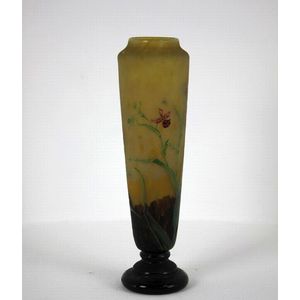Bohemian Floral Vases - Hand Painted Glass
You must be a subscriber, and be logged in to view price and dealer details.
Subscribe Now to view actual auction price for this item
When you subscribe, you have the option of setting the currency in which to display prices to $Au, $US, $NZ or Stg.
- Socle - The short plinth, usually cylindrical, that serves as a pedestal for a sculpture or vase
- Cased Glass - Cased glass is a type of glassware that is made by sandwiching a layer of one colour of glass between two layers of another colour of glass. This technique is also known as "slip-casting" and "slip-decorated" or "overlay" glass. The process creates a decorative effect by contrasting the colours of the outer layers with the inner layer. The outer layers can be clear, opaque or coloured and the inner layer can be a different colour, or it can be left clear to create a more subtle effect.
The technique was first developed in the 19th century, primarily in Europe, and it was used to produce a wide range of decorative glassware such as vases, bowls, and bottles. Cased glass was particularly popular during the Art Nouveau period, when many glassmakers, including Loetz, Galle, Steuben and Tiffay began to experiment with different colours and designs to create unique and striking pieces of glassware. - Pontil Mark - A pontil mark, also known as a pontil scar, is a distinctive mark or scar found on the base of certain types of glass. It is a remnant of the glassblowing process and is particularly associated with handcrafted items made prior to the widespread use of automated manufacturing.
The pontil mark is created during the final stages of production. After the glassblower has shaped and formed the glass object, it is removed from the blowing iron. At this point, the glass object is often attached to a solid rod called a pontil rod or punty for further shaping, finishing, or attaching additional components. The attachment point is typically at the base of the object.
Once the glass item is complete, it is detached from the pontil rod, leaving behind a mark or scar on the base. This mark can take various forms, such as a rough or irregular surface, a concave or slightly recessed area, or a small circular scar. The presence of a pontil mark indicates that the item was handcrafted rather than mass-produced.
Collectors and historians often use pontil marks as clues to determine the age, authenticity, and production methods of glass or ceramic pieces. Different types of pontil marks may suggest different techniques used in the production process. For example, an open pontil mark is one where the scar is left as an exposed, roughened area, while a closed pontil mark occurs when the scar is smoothed or covered in some way. It's important to note that not all handcrafted glass items have pontil marks, as some artisans developed alternative methods for finishing their work. In Edwardian times the pontil mark was oftern ground off leaving a concave circle in the centre of the base of the object.
The use of pontil marks diminished with the advent of industrialization and automated manufacturing processes in the 19th and 20th centuries.
This item has been included into following indexes:
-
Bohemian (Czech Republic) glass wares
- various wares 442
- vases 227
Visually similar items

A group of three Carlton Ware blue vases, two items from the first quarter 20th century; the third after 1925, a baluster vase with a deep lustre in 'Stork and Bamboo' pattern 2932, a trumpet shaped footed vase with an ornate frieze and pagodas in 'Kang Hs

Bohemian goblet glass painted gilt borders, fluted body 19th century, 11 cm high

A Daum Nancy acid etched cameo and enamelled glass vase, circa 1900. Baluster form on a circular base, the mottled yellow ground enamelled with red Columbine flower and green stems, acid etched Daum Nancy. 31 cm high.

Two Wedgwood jasperware vases, 15 cm high approx.
